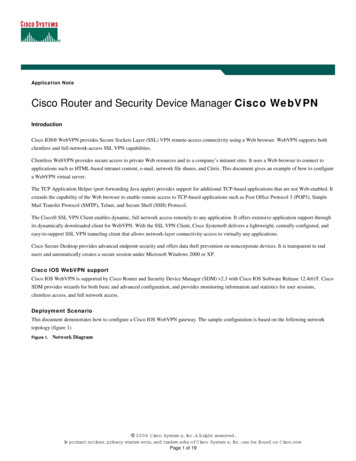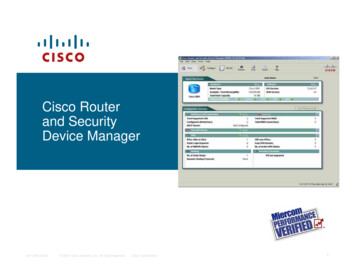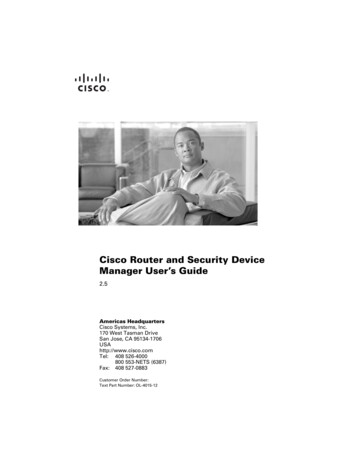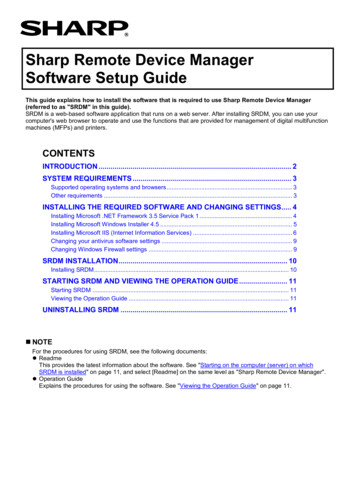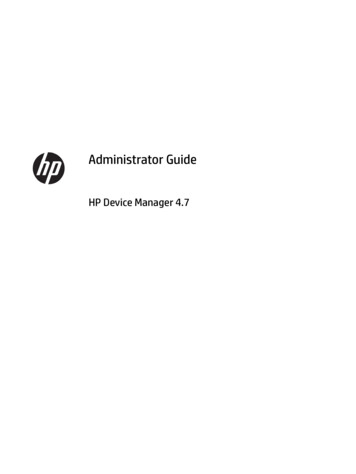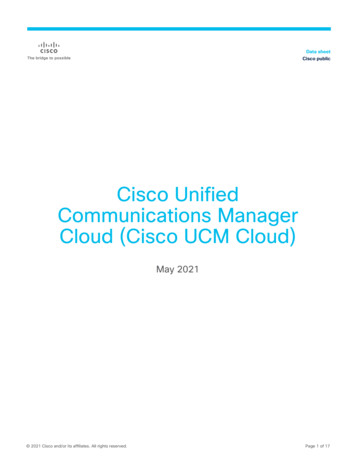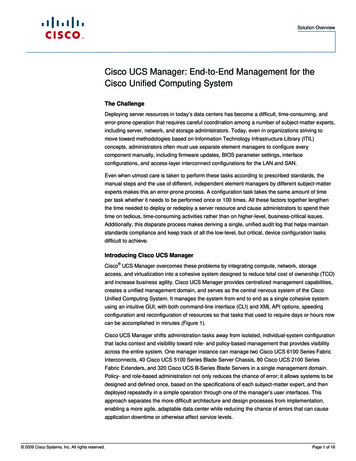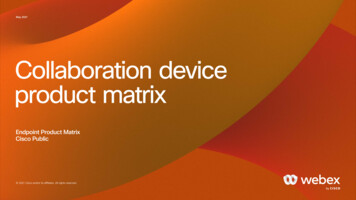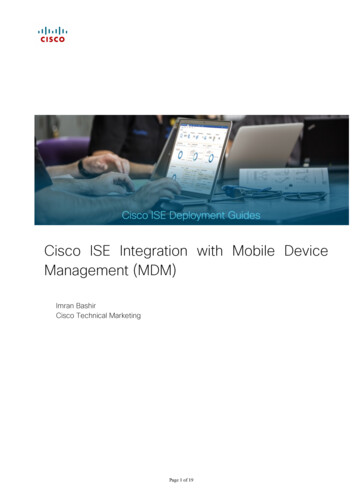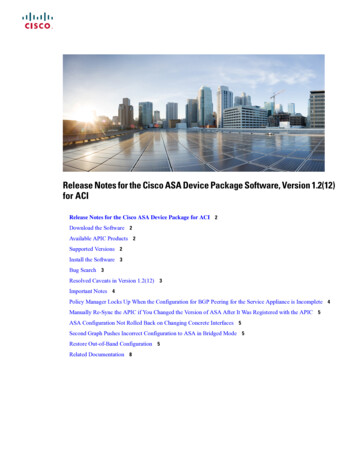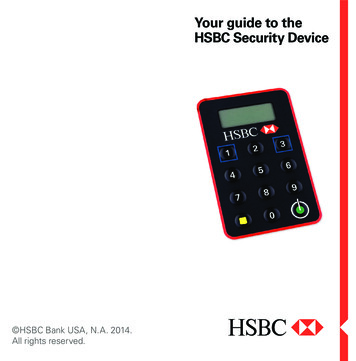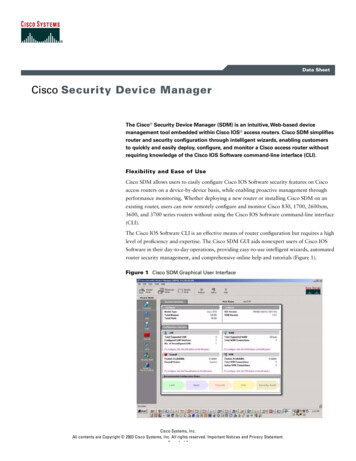
Transcription
Data SheetCisco Security Device ManagerThe Cisco Security Device Manager (SDM) is an intuitive, Web-based devicemanagement tool embedded within Cisco IOS access routers. Cisco SDM simplifiesrouter and security configuration through intelligent wizards, enabling customersto quickly and easily deploy, configure, and monitor a Cisco access router withoutrequiring knowledge of the Cisco IOS Software command-line interface (CLI).Flexibility and Ease of UseCisco SDM allows users to easily configure Cisco IOS Software security features on Ciscoaccess routers on a device-by-device basis, while enabling proactive management throughperformance monitoring. Whether deploying a new router or installing Cisco SDM on anexisting router, users can now remotely configure and monitor Cisco 830, 1700, 2600xm,3600, and 3700 series routers without using the Cisco IOS Software command-line interface(CLI).The Cisco IOS Software CLI is an effective means of router configuration but requires a highlevel of proficiency and expertise. The Cisco SDM GUI aids nonexpert users of Cisco IOSSoftware in their day-to-day operations, providing easy-to-use intelligent wizards, automatedrouter security management, and comprehensive online help and tutorials (Figure 1).Figure 1 Cisco SDM Graphical User InterfaceCisco Systems, Inc.All contents are Copyright 2003 Cisco Systems, Inc. All rights reserved. Important Notices and Privacy Statement.P1 f7
Cisco SDM wizards guide users step-by-step through router configuration and security configuration workflow bysystematically configuring LAN and WAN interfaces, firewalls, and VPNs. Cisco SDM wizards can intelligently detectincorrect configurations and propose fixes, such as allowing Dynamic Host Control Protocol (DHCP) traffic througha firewall if the WAN interface is DHCP addressed. Online help embedded within Cisco SDM contains appropriatebackground information, in addition to step-by-step procedures to help users enter correct data in Cisco SDMapplication windows. Networking and security terms and definitions that users might encounter are included in anonline glossary.For network professionals familiar with Cisco IOS Software and its security features, Cisco SDM offers an advancedmode to quickly configure and fine-tune router security features, allowing network professionals to review thecommands generated by Cisco SDM before delivering the configuration changes to the router. Advanced users canalso quickly fine-tune configurations using features such as the access control list (ACL) editor.Cisco SDM enables all types of users to configure and monitor routers from remote locations using Secure SocketsLayer (SSL) connections (Figure 2). This technology enables a secure connection, over the Internet, between the user’sbrowser and the router. When deployed at a branch office, a Cisco SDM-enabled router can be configured andmonitored from corporate headquarters, reducing the need for IT support at the branch.Figure 2 Connecting to a Cisco SDM-Enabled Router Using SSL for Secure Remote ConnectivitySSL ConnectionInternetSSL ConnectionRemote User ConfiguringRouter Using SDMCisco Routerwith SDMSecurity ConfigurationWhen deploying a new router, Cisco SDM can be used to quickly configure Cisco IOS Firewall using best practicesrecommended by the International Computer Security Association (ICSA) and the Cisco Technical Assistance Center(TAC). Cisco SDM users can configure the strongest VPN defaults, and automatically performs security audits (Figure3). In addition, Cisco SDM users can perform one-step router lockdown for firewalls and one-step VPN for quickdeployment of secure site-to-site connections.Cisco Systems, Inc.All contents are Copyright 2003 Cisco Systems, Inc. All rights reserved. Important Notices and Privacy Statement.P2 f7
Figure 3 Router Security AuditWhen installed on an existing router, Cisco SDM allows users to perform one-step security audits to evaluate thestrengths and weaknesses of their router configurations against common security vulnerabilities. Using the advancedmode, administrators can fine-tune their existing security configurations to better suit their business needs. Cisco SDMcan also be used for ongoing monitoring, fault management, and troubleshooting.Router ConfigurationIn addition to security configuration, Cisco SDM enables users to quickly and easily perform basic routerconfiguration, such as LAN and WAN interface configuration. Using the LAN configuration wizard, users can assignIP addresses and subnet masks to Ethernet interfaces, and can enable or disable DHCP server.Using the WAN configuration wizard, T1/E1, Ethernet, and xDSL interfaces can be assigned static or dynamic IPaddress as well as subnet masks. Additionally, for serial connections, Frame Relay, Point-to-Point Protocol (PPP), andHigh-Level Data Link Control (HDLC) encapsulation can be implemented. Using Cisco SDM, authentication can beconfigured for PPP connections, and for Frame Relay connections, Local Management Interface (LMI) and data-linkconnection identifier (DLCI) parameters can be entered. Cisco SDM also allows configuration of common routingprotocols like OSPF, RIP, and EIGRP.MonitoringIn “monitor” mode, Cisco SDM provides an overview of router status and performance metrics such as the Cisco IOSSoftware release, interface status (up or down), and CPU and memory usage. Monitor mode also allows users to viewthe number of network access attempts that were denied by Cisco IOS Firewall, and provides easy access to the firewalllog. Additionally, VPN status, such as the number of active IP Security (IPSec) tunnels, can be monitored. Interfaces,firewall, VPN, and logging status and performance may also be monitored independently, and with greater detail.Cisco Systems, Inc.All contents are Copyright 2003 Cisco Systems, Inc. All rights reserved. Important Notices and Privacy Statement.P3 f7
Cost SavingsCisco SDM is ideal for enterprise branch offices and small and medium-sized businesses that are sensitive to networkmanagement costs. Cisco SDM allows businesses to implement router security configurations on a device-by-devicebasis and in a timely manner—without purchasing new network management software. For businesses with largernetworks, Cisco SDM enables easy deployment of individual routers—by nonexpert administrators—at branchoffices. These devices can then be managed from corporate headquarters through central management tools, providingcost savings in terms of time and IT support expenses at the branch office.Cisco SDM and Other Cisco Management ApplicationsCisco offers additional device management and network management applications that can be used in conjunctionwith Cisco SDM. CiscoView, a Web-based management application, can be installed on a dedicated CiscoWorksserver to display and monitor the physical view of Cisco devices. Cisco SDM and CiscoView client interfaces cancoexist on the same workstation—Cisco SDM can be used primarily for router and security feature configuration,while CiscoView can be used for real-time display of the physical router status and for Simple Network ManagementProtocol (SNMP) based device monitoring. Cisco QoS Device Manager (QDM), a Web-based quality of service (QoS)management application, and Cisco SDM can also coexist on the router, where Cisco QDM is used primarily toconfigure QoS-related Cisco IOS Software configurations on the router.Cisco IP Solution Center (ISC) and CiscoWorks VPN/Security Management Solution (VMS) both offer highly scalablesecurity management solutions for Cisco IOS routers. Cisco ISC can cost-effectively scale to 10,000 or more devices.Cisco SDM complements these centralized management solutions by aiding in the deployment of LAN, WAN, andsecurity features on a router through intelligent wizards that can detect and correct any security configurationmismatches at the device level.For Cisco 830 series routers, either the Cisco Router Web Setup (CRWS) tool or Cisco SDM can be used forconfiguration. CRWS is ideally suited for deploying multiple Cisco 830 series routers with the same configuration.Cisco SDM should be used when various site-specific configurations are required.Table 1 lists the features and benefits of Cisco SDM.Table 1 Features and Benefits of Cisco SDMFeatureBenefitEmbedded Web-basedmanagement tool Turns the router into a complete solution with its own management tool Does not require a separate management station Allows remote management from any supported desktop or laptopSSL-based secure remote access Secure management across the WANAt-a-glance router status views Provides a quick inventory of router hardware, software, and securityconfigurationsCisco Systems, Inc.All contents are Copyright 2003 Cisco Systems, Inc. All rights reserved. Important Notices and Privacy Statement.P4 f7
Table 1 Features and Benefits of Cisco SDM (Continued)FeatureBenefitRouter security audit Assesses existing network infrastructure against common securityvulnerabilities Provides quick compliance to expert (TAC, ICSA) recommended securitypolicies for routersOne-step router lockdown Simplifies firewall configuration without requiring expertise on security orCisco IOS SoftwareWizards to assist users in quickconfiguration of Cisco IOSSoftware security features likefirewall, VPN, and NetworkAddress Translation (NAT) Reduces training needs for network administrators on new Cisco IOS Softwaresecurity features Easily and cost-effectively secures the existing network infrastructureStartup wizard Reduces Cisco router deployment time and complexityAdvanced configuration mode Allows security experts to fine-tune security policies based on site-specificrequirementsPreview Cisco IOS Software CLIcommands Helps build Cisco IOS Software expertiseACL management (editor) Advanced users can easily and quickly manage ACLsMonitoring and logging Helps troubleshoot security-related issues and manage router performancebefore it affects mission-critical applications in the networkIntegrated online help andtutorials Reduces the need for IT staff to keep up with security technology updates andcomplex security configurationsTable 2 lists specifications of Cisco SDM.Table 2 Cisco SDM SpecificationsSpecificationsCisco SDMSupported platforms Required Cisco IOS Software Cisco IOS Software Release 12.2(11)T6 or later (Refer to the SDM FAQ foradditional details)Memory requirements Cisco SDM requires at least 2.3 MB of free Flash memory on the routerOperating system requirements Cisco 831, 836, and 837Cisco 1710, 1721, 1751, and 1760Cisco 2610XM, 2611XM, 2620XM, 2621XM, 2650XM, 2651XM, and 2691Cisco 3620, 3640, 3661, and 3662Cisco 3725 and 3745Windows 2000Windows NT 4.0 (Service Pack 4)Windows 98Windows MEWindows XPCisco Systems, Inc.All contents are Copyright 2003 Cisco Systems, Inc. All rights reserved. Important Notices and Privacy Statement.P5 f7
Table 2 Cisco SDM Specifications (Continued)SpecificationsCisco SDMBrowser requirements Microsoft Internet Explorer 5.5 or later Netscape Navigator 4.79Java requirements The client device must have a browser that supports JDK 1.1.4 as supported inthe Internet Explorer and Netscape browsers Java plug-in, JRE2 version 1.3.1 or laterRecommended connectionspeed 56 Kbps or greaterBasic router configurationparameters Advanced router configurationparameters Routing protocols: Static, Routing Information Protocol (RIP), Open ShortestPath First (OSPF), and Enhanced Interior Gateway Routing Protocol (EIGRP) NAT ACLsConfigurable WAN interfaces Ethernet xDSL T1/E1Supported WAN encapsulations Frame RelayPPPPPP over Ethernet (PPPoE)RFC 1483 routingHDLCConfigurable VPN parameters Internet Key Exchange (IKE)IPSecEasy VPN RemoteGeneric routing encapsulation (GRE) tunnelSupported firewall parameters Context-Based Access Control (CBAC)CiscoView compatibility Can be used with Cisco SDMCisco QDM compatibility Can be used with Cisco SDMLicense No license fee requiredAvailability Factory installed on all Cisco 1700 2600xm, 3600, and 3700 VPN bundles Optional factory installation available on all supported Cisco router models Posted on www.Cisco.com Software Center for free downloadIPPasswordsUsersDomain Name System (DNS)DHCPSNMPTelnetCisco Systems, Inc.All contents are Copyright 2003 Cisco Systems, Inc. All rights reserved. Important Notices and Privacy Statement.P6 f7
Corporate HeadquartersCisco Systems, Inc.170 West Tasman DriveSan Jose, CA 95134-1706USAwww.cisco.comTel: 408 526-4000800 553-NETS (6387)Fax: 408 526-4100European HeadquartersCisco Systems International BVHaarlerbergparkHaarlerbergweg 13-191101 CH AmsterdamThe Netherlandswww-europe.cisco.comTel: 31 0 20 357 1000Fax: 31 0 20 357 1100Americas HeadquartersCisco Systems, Inc.170 West Tasman DriveSan Jose, CA 95134-1706USAwww.cisco.comTel: 408 526-7660Fax: 408 527-0883Asia Pacific HeadquartersCisco Systems, Inc.Capital Tower168 Robinson Road#22-01 to #29-01Singapore 068912www.cisco.comTel: 65 6317 7777Fax: 65 6317 7799Cisco Systems has more than 200 offices in the following countries and regions. Addresses, phone numbers, and fax numbers are listed on theCisco Web site at www.cisco.com/go/officesArgentina Australia Austria Belgium Brazil Bulgaria Canada Chile China PRC Colombia Costa Rica CroatiaCzech Republic Denmark Dubai, UAE Finland France Germany Greece Hong Kong SAR Hungary India Indonesia IrelandIsrael Italy Japan Korea Luxembourg Malaysia Mexico The Netherlands New Zealand Norway Peru Philippines PolandPortugal Puerto Rico Romania Russia Saudi Arabia Scotland Singapore Slovakia Slovenia South Africa Spain SwedenS w i t z e r l a n d Ta i w a n T h a i l a n d Tu r k e y U k r a i n e U n i t e d K i n g d o m U n i t e d S t a t e s Ve n e z u e l a Vi e t n a m Z i m b a b w eAll contents are Copyright 199
Posted on www.Cisco.com Software Center for free download Table 2 Cisco SDM Specifications (Continued) Specifications Cisco SDM. Corporate Headquarters Cisco Systems, Inc. 170 West Tasman Drive San Jose, CA 95134-1706 USA www.cisco.com Tel: 408 526-4000 800 553-NETS (6387) Fax: 408 526-4100 European Headquarters Cisco Systems International BV Haarlerbergpark Haarlerbergweg File Size: 234KBPage Count: 7
